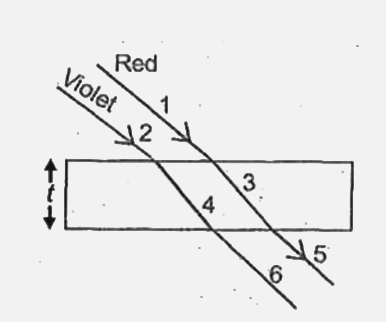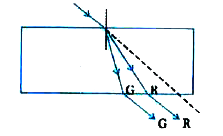A mixed ray of red and green colour incidents obilquely on surface of rectangular glass slab. After passing through slab, the rays of red and violet colour emerging out surface parallel to incident surface are…..Solution in Gujrati
emerging out from same point and moving in same direction.
observed to be coming out from different points and moving in different directions.
observed to be coming out from different points and moving parallelly.
emergingout from same point and moving in different directions.
The correct Answer is:A, B, C, D
Topper's Solved these Questions
- BOOK - KUMAR PRAKASHANCHAPTER - RAY OPTICS AND OPTICAL INSTRUMENTSEXERCISE - SECTION-D (MULTIPLE CHOICE QUESTIONS (MCQs))(MCQs FROM .DARPAN. BASED ON TEXTBOOK)(MCQs BASED ON TEXTUAL ILLUSTRATION AND EXERCISE)24videos
RAY OPTICS AND OPTICAL INSTRUMENTS
- BOOK - KUMAR PRAKASHANCHAPTER - MOVING CHARGES AND MAGNETISMEXERCISE - SECTION D (MCQs ASKED IN COMPETITIVE EXAMS)34videos
MOVING CHARGES AND MAGNETISM
- BOOK - KUMAR PRAKASHANCHAPTER - SAMPLE QUESTION PAPER EXERCISE - PART-B SECTION-C5videos
SAMPLE QUESTION PAPER
Similar Questions
The earth takes 24 h to rotate once about its axis. How much time does the sun take to shift by 1° when viewed from the earth?
03:42View SolutionElectric charge Q having mass M moves on a circular path of radius R with velocity →v, perpendicular to uniform magnetic field B. When a particle completes one revolution, work done by the field is _______
View SolutionTwo charges –q and +q are located at points (0, 0, –a) and (0, 0, a), respectively.
(a) What is the electrostatic potential at the points (0, 0, z) and (x, y, 0) ?
(b) Obtain the dependence of potential on the distance r of a point from the origin when r/a>>1 .
(c) How much work is done in moving a small test charge from the point (5,0,0) to (–7,0,0) along the x-axis? Does the answer change if the path of the test charge between the same points is not along the x-axis?03:22View SolutionA beam of light composed of red and green ray is incident obliquely at a point on the face of rectangular glass slab. When coming out on the opposite parallel face, the red and green ray emerge form
01:42View SolutionA ray of white light passes through a rectantular glass slab, entering and emerging at parallel faces. The angle of incidence, measured from the normal to the glaass surface, is large.
01:26View SolutionWhen light passes through glass slab, the incident ray and emergent ray are ……………………. .
03:15View SolutionA beam of light composed of red and green rays is incident obliquely at a point on the face of rectangular glass slab. When coming out onn the opposite parellel face, the red and green rays emerge from
View SolutionTwo parallel rays of red and violet colour passed through a glass slab, which of the following is correct?
 04:21View Solution
04:21View SolutionA light ray is incident at an angle 45∘ on parallel sided glass slab and emerges out grazing the vertical surface. The refractive index of the slab is
01:16View SolutionA red ray and a violet ray passing through a glass slab are incident simultaneously on an interface with air. It is seen that the red ray is refracted but the violet ray is reflected. Explain the reason behind it.
02:44View Solutiona red ray and a violet ray are incident simultaneously on a glass slab. It is seen that the red ray is refracted but the violet ray is reflected. Explain the reason.
View SolutionA ray of white light passes through a rectangular glass slab, entering and emerging at parallel faces. The angle of incidence measured from the normal to the glass surface, is large. Then
02:31View SolutionWhen a light ray emerges out after refraction at a rectangular glass slab, it is parallel to the incident ray. Why ?
01:22View SolutionA beam of light of red and green rays is incident obliquely at a point on a face of rectangular glass slab. When coming out on the opposite parallel face, the red and green rays emerge from
02:22View SolutionA beam of light composed of red and green rays is incident obliquely at a point on the face of rectangular glass slab. When coming out onn the opposite parellel face, the red and green rays emerge from
04:23View Solution


